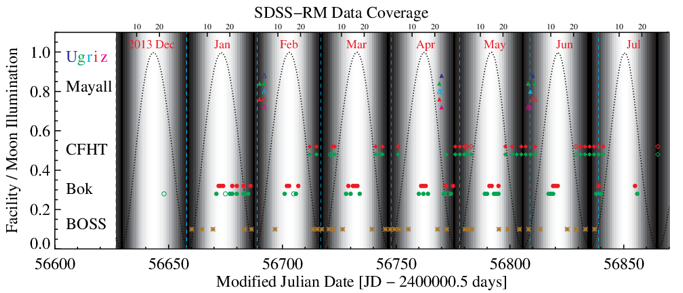Home Program Data Publications Internal wiki

The Sloan Digital Sky Survey Reverberation Mapping Project
Facilities
The sky density of quasars is low. To observe ~1000 quasars simultaneously on the sky we require wide-field spectrographs and imagers.
Spectroscopy

Among the 1000 fibers, 849 were assigned to RM quasar targets; 1 was assigned to a galaxy target per BOSS tiling requirement; 70 were assigned to spectrophotometric F stars; 80 were assigned to sky observations.
Imaging

The RM Field
This field has a good annual visibility window from APO, and has been fully or partially covered by various multi-wavelength facilities such as Chandra and HST.
The Quasar Sample
The quasar sample is a flux-limited (i<21.7), spectroscopically confirmed broad-line quasar
sample that covers a wide redshift range (0.1<z<4.5).

The Baseline Program
The baseline program had a length of 6 months (2014A semester) over 7 dark/grey runs, with 3-6 BOSS spectroscopic epochs per run (cadence of a few days). Each spectroscopic epoch performed simultaneous spectroscopy for ~ 850 flux-limited quasars in a single, 7 deg2 field. The photometric monitoring came from CFHT/MegaCam (dark time), Bok 2.3m/90Prime (bright) and KPNO-4m/MOSA (dark time), and had a cadence of ~ 2 days over the same period, covering both dark and bright times.

The Extended Program
The SDSS-RM field will continue to be monitored by the BOSS spectrograph through 2016, albeit with a lower cadence. These additional spectroscopic epochs, when combined with four prior years of photometric light curves from PanSTARRS 1 and SDSS-RM, will enable the detection of long (>6 months) lags in our RM sample.
Science Cases
The unique dataset from SDSS-RM will enable an array of applications for RM science and general quasar science.
RM science
-
•BLR lag detections
-
•BLR size-luminosity (R-L) relations
-
•Host - RM BH mass correlations
General quasar science
-
•Photometric and spectral quasar variability
-
•Broad absorption trough variability
-
•Deep spectroscopy of quasar absorption lines
-
•High-resolution and deep imaging of quasar hosts
-
•Spectral decomposition of AGN and host components
-
•Multi-wavelength synergy on RM quasars
